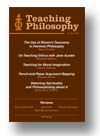|
articles |
|
1.
|
Teaching Philosophy:
Volume >
31 >
Issue: 4
Maria Cimitile
The Use of Bloom’s Taxonomy in Feminist Philosophy
abstract |
view |
rights & permissions
| cited by
Overcoming our disciplinary aversion to assessment mechanisms allows more possibilities for students to achieve fundamental philosophical skills. My essay discusses the use of Bloom’s taxonomy in a Feminist Philosophy course with detailed examples that demonstrate its efficacy as a learning and assessment tool that is particularly suited to philosophy, as well as how critical philosophy in general, and feminist philosophy in particular, is an ideal subject to help students gain critical thinking skills.
|
|
|
|
|
2.
|
Teaching Philosophy:
Volume >
31 >
Issue: 4
Margaret Watkins
Persuasion and Pedagogy:
On Teaching Ethics with Jane Austen
abstract |
view |
rights & permissions
| cited by
Recent moral philosophy emphasizes both the particularity of ethical contexts and the complexity of human character, but the usual abstract examples make it difficult to communicate to students the importance of this particularity and complexity. Extended study of a literary text in ethics classes can help overcome this obstacle and enrich our students’ understanding and practice of mature ethical reflection. Jane Austen’s Persuasion is an ideal text for this kind of effort. Persuasion augments the resources for ethical reflection that students bring to our courses, provides a multitude of fecund examples to inspire discussion, and introduces philosophical points of its own. I explain specific ways to integrate this novel into courses and why some approaches work better than others, and I highlight themes for three different levels of study: reflection on particular virtues and vices, illustration of broader ethical issues, and discussion of virtues that the philosophical literature neglects. In each case, I discuss a particular example in detail: the question of whether or not pride can be a virtue, the varieties of friendship and their relation to virtue, and the virtue of proper persuadability. These examples suggest ways in which ethics teachers might explore the resources of other literary works towards similar ends.
|
|
|
|
|
3.
|
Teaching Philosophy:
Volume >
31 >
Issue: 4
Robert Kirkman
Teaching for Moral Imagination:
Assessment of a Course in Environmental Ethics
abstract |
view |
rights & permissions
| cited by
This paper reports the results of an assessment project conducted in a semester-length course in environmental ethics. The first goal of the project was to measure the degree to which the course succeeded in meeting its overarching goal of enriching students’ moral imagination and its more particular objectives relating to ethics in the built environment. The second goal of the project was to contribute toward a broader effort to develop assessment tools for ethics education. Through qualitative analysis of an exit survey and of a pair of writing assignments, the study yielded some promising results, outlined here, and suggested particular ways of improving both the course and the assessment procedure.
|
|
|
|
|
4.
|
Teaching Philosophy:
Volume >
31 >
Issue: 4
Maralee Harrell
No Computer Program Required:
Even Pencil-and-Paper Argument Mapping Improves Critical-Thinking Skills
abstract |
view |
rights & permissions
| cited by
Argument-mapping software abounds, and one of the reasons is that using the software has been shown to teach/promote/improve critical-thinking skills. These positive results are very encouraging, but they also raise the question of whether the computer tutorial environment is producing these results, or whether learning argument mapping, even with just paper and pencil, is sufficient. Based on the results of two empirical studies, I argue that the basic skill of being able to represent an argument diagrammatically plays an important role in the improvement of critical-thinking skills. While these studies do not offer a direct comparison between the two methods, it is important for anyone wishing to employ argument mapping in the classroom to know that significant results can be obtained even with the most rudimentary of tools.
|
|
|
|
|
5.
|
Teaching Philosophy:
Volume >
31 >
Issue: 4
Raymond S. Pfeiffer
Detecting Spirituality and Philosophizing About It
abstract |
view |
rights & permissions
| cited by
Often viewed as the deep common core of all religions, spirituality has been addressed in a direct philosophical manner only occasionally. After noting some recent philosophical literature, a questionnaire for evaluating a person’s spirituality is described, and a general theory of spirituality is advanced. Spirituality is, generally, the yearning for, quest for, experience of or belief in a great reality that is largely beyond ordinary experience and that inspires one’s interior, private life and one’s behavior and ultimate values. This idea illuminates the main questions of the philosophy of religion, and also questions of the consistency of thought and action, essentialism, naturalism, religious liberalism, and the reproductive fallacy.
|
|
|
|
|
reviews |
|
6.
|
Teaching Philosophy:
Volume >
31 >
Issue: 4
Jean Keller
Does Feminism Discriminate Against Men?
view |
rights & permissions
| cited by
|
|
|
|
|
7.
|
Teaching Philosophy:
Volume >
31 >
Issue: 4
Mark McLeod-Harrison
God, Evil, and Design:
An Introduction to the Philosophical Issues
view |
rights & permissions
| cited by
|
|
|
|
|
8.
|
Teaching Philosophy:
Volume >
31 >
Issue: 4
Maurice Hamington
Feminist Interpretations of Emma Goldman
view |
rights & permissions
| cited by
|
|
|
|
|
9.
|
Teaching Philosophy:
Volume >
31 >
Issue: 4
Aaron Parks Smith
Historical Dictionary of Existentialism
view |
rights & permissions
| cited by
|
|
|
|
